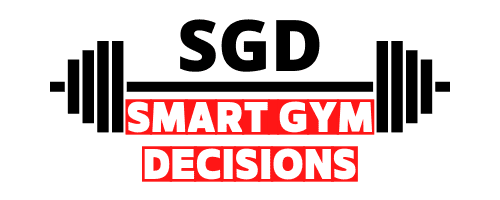For some people pull-ups are easy to perform, for the majority of people it can be hard to achieve 1 single pull-up. In order to learn how to do a pull-up and to keep progressing you’ll need to nail the prerequisites (your foundation). In this post you’ll find all the information that you need to build a sculpted upper body and untapped strength.
This is about mastering the fundamentals and in a few months or even in weeks, after reading this post, you’ll be one step closer to achieve your fitness goals or more specifically, your pull-up goals.
How to do a Pull-up in 5 Steps
- Why Are Pull-ups a Bad Ass Exercise?
- The Essential Pull-up Warm-up
- How to Go From 0 to 10 Pull-ups?
- Break Through Your Plateaus: Achieve a 1RM 100Ib Pull-up
- The Ultimate Pull-up Routine
Subscribe to SGD For More Fitness Content
1. Why Are Pull-ups a Bad Ass Exercise?
Why did I choose to write a post about pull-ups? Well, simply because this is a bad ass exercise, with a high difficulty degree that can enhance your physique like crazy. The pull-up combines different mechanisms and you’ll need to improve all of them. I’m talking about improving your pull-up technique, full body strength, controlled mobility and stability.
What I’m trying to say it’s that you need your whole body to work together, because the pull-up is a complex exercise, but if done properly, you’ll notice a great aesthetic improvement and strength gains. Also, do you really think people care about your leg press 400Ib record? Well, they don’t! Instead try to improve your pull-ups they’re much better to show off.
From 0 to 100Ib Pull-Ups
I remember when I was 17 years old and I couldn’t even do 1 rep… I’ve to say that I got my first pull-up quite fast (like in two weeks), although that happened because I played sports, specially swimming, and that can translate a lot to your pull-up potential. So, don’t worry if you can’t get your first pull-up as fast as myself.
After getting my first pull-up, it was a matter of time until I was able to do 5 pull-ups in a row, then 10 pullups and after that you need to add a belt so you can add some weight and keep scaling. I did that until I stalled at a 40Ib pull-up, and that was the time when I had to learn about periodization and how to plan my training program properly. Since then I reached a 1RM 100Ib pull-up (it’s more like a 97Ib pull-up, but 100Ib looks better).
https://www.pinterest.pt/pin/1065312486830406116/I think a 100Ib pull-up is a tremendous achievement, and for someone that’s reading this article and has never done 1 pull-up or it’s doing sets of 5 reps, this record might sound overwhelming. What I want you to do is to just forget about my record! Seriously tell my personal record to go take a walk! The reason I want you to forget about the 100Ib pull-up it’s because the biggest problem that beginners have it’s that they want too much too soon.
Beginners see some guy or girl in really good shape, lifting big weights and they automatically wish they were like them. What beginners don’t know its that behind a great natural physique and behind amazing personal records there’s lots of work.
Consistency is the key word here. I know it’s a boring word, but the perfect workout routine or the optimal diet plan won’t do anything for you, if you don’t stick with your plan and stay consistent.
Take your time and master the fundamentals, and you’ll be one step closer to achieve your goals.
2. The Essential Pull-up Warm-up
If you’re getting ready to get injured, than you should skip this step!
The truth it’s that you need to warm-up properly for longevity. When you’re a newbie at the gym it’s easy to just start working out, without a proper warm-up, but the more advanced you get, the more likely it’ll be for you to get injured. So an effective warm-up is fundamental. Think about it! If you don’t warm-up correctly, you’ll eventually pick some injuries that’ll nag you and will affect your training program.
A pull-up warm-up will reduce the risk of injury by increasing muscular performance and by improving your range of motion.
The warm-up has to be centered around 3 distinct phases: raise, activation & mobilization and finally, potentiation.
Raise
First of all, lets start with the “raise” phase. In this part of the workout you should look to add some low intensity aerobic exercise. The goal here, it’s just to elevate the blood flow to the muscles.
Because you’ll train the back muscles and the biceps, use the rowing machine between 5 to 15 minutes, and that will do it.
Activation & Mobilization
The most common pull-up injuries are wrist, elbow and shoulder related. So guess what do you need to activate and mobilize first?
The following exercises can help you activate and mobilize your muscles:
In the wrists, you can do weighted wrist rotations and wrist extension and flexion, Do 10-15 reps on both sides, this will put your wrists ready to go.
For the elbows, do elbow circles for 10-15 reps. Your biceps and forearms will be good to go.
To finish, you need to warm-up the shoulders. So, the two exercises that I recommend are the serratus wall slide and the scapula wall slide. The goal of these two exercises is to put your shoulder blades and scapula moving properly, The following videos will show you how to perform both exercises:
Potentiation
With potentiation your goal it’s to work your intensity up towards your working sets bodyweight pull-ups or weighted pull-ups.
At this stage, you can do a single-arm resistance band pulldown and you can do band assisted pull-ups.
In my case, I like to start with a single-arm resistance band pulldown and after that I do bodyweight pull-ups and weighted pull-ups. Because I’m more advanced, assisted pull-ups doesn’t get me ready to my working sets.
After all of this warm-up phases you’re ready to go.
3. How to Go From 0 to 10 Pull-ups?
If you’re a complete newbie that doesn’t know how to do a pull-up, here’s what you should do:
- Your goal is: “I want to do 5 reps”. If you’re a newbie, this goal might be a little hard to achieve in the beginning, so next step…;
- Jump until you’ve your chin over the bar – hold that position for 1–2 seconds – start the descent (eccentric part of the movement), but control it, take 3–4 seconds until you reach the bottom part of the movement and repeat (do this 10 times).
REMEMBER: Jump-Hold-Control descent
Next: How can you progress?
Hold the top position for longer periods of time, and do the descent even more slowly. After doing this, you’ve to try to do one rep without jumping. ONE FULL REP.
I did this myself when I started training. You then can progress by doing 3 sets of 1 full rep, next 2 reps, next 3 reps, 4, 5, and so on… until you can do 10 reps. If you reach a stage where you perform 3 sets of 10 reps, now it’s time to do weighted pull-ups, but I’ll speak in more detail on the next section.
After reading all of these tips about getting your first pull-ups, you’re ready to start pulling up, but you should know that there’s more to it, than just grabbing a bar and do pull-ups. You need to train your whole body, but since this post is about pull-ups, the exercises that you need to do, besides pull-ups or chin-ups, are rowing movements.

Accessory Work
To plan your back workout, that has the ultimate goal of increasing your pull-up record, you’ve to start focusing on hypertrophy and on building the back musculature.
To do so, take a look at this list of back exercises:
- Deadlift
- Barbell row
- One-arm dumbbell row
- Seated cable row
- Lat pulldown
Your long-term training program should include these exercises, so you can get a good training stimulus and you’ll be constantly adapting, in other words you’ll get stronger and bigger and “a bigger muscle is a stronger muscle”.
You see the picture, right? If your muscles are stronger and bigger, that means you can deal with higher training intensities, which will carryover to your pull-up or chin-up potential.
4. Break Through Your Plateaus: Achieve a 1RM 100Ib Pull-up
If you’re a beginner and you’ve been following my advice so far, you’ll be progressing in a week-to-week bases, because beginners recover really fast. Although it’ll come a time that you aren’t a beginner anymore and you’ll pick some injuries that will slow you down or you’ll hit a plateau.
Personally, I hit a plateau when I reached the 40Ib mark. At the time I would plan my workouts and I would choose the exercises that I wanted to perform and how many sets and reps I would do. However I didn’t know much about progressions and periodization.
So, I could do 5 weighted pull-ups with 40Ib in my belt and that was it, my beginner gains stopped and I could no longer progress, from week to week. I had to learn about periodization in order to keep getting stronger. If you’re a beginner your weekly gains will stop, unless you program things correctly, and if so, you’ll still make gains, but now in a much slower pace. There’s nothing you can do about it, as you reach the intermediate level your gains will slow down, but check this out…
Do you remember when I said that I’ve hit a plateau at the 40Ib mark for 5 reps? Well, since I expanded my fitness knowledge and I learnt about periodization, I was able to beat that plateau. I did 10 reps with 40Ib, I did 6 reps with 60Ib and my 1RM is 97Ib. That’s my current record and I’m working to achieve new records, but there’s lots of people that lift much more than me and they don’t have a special trick. The key is consistency and everything that I’ve already speak of.
Linear periodization
Right now, I’m going to focus, exclusively, on the linear periodization model, since this is a very good and easy to understand model, that can be easily applied in compound movements.
Linear periodization – a model of training planning in which volume decreases as intensity increases over time. Keep sets the same, reduce reps each session and increase load.
What should you focus on to understand linear periodization?
The load, reps and volume will change workout to workout, but the load will increase every repeat of the cycle. You can apply this in different rep ranges (3-5; 6-8; 10-12).

Now lets say that you train the same compound movement 3 times per week and on each day you work with different rep ranges. Then you can focus one phase of your mesocycle to higher volume and higher reps training, and after this phase you do lower volume training and finally you can do a taper and do an AMRAP. Here’s what it would look like:

As you can see, I only explained one periodization model that’s easier to understand. To learn how to do a pull-up or a 100Ib pull-up, you’ll need to also plan accessory exercises that’ll make you take the most out of your pull-ups.
5. The Ultimate Pull-up Routine
Now you know how to progress, and also know which exercises can help you achieve your pull-up goals and develop a powerful back.
The final step, puts all of these tips together and creates the ultimate pull-up routine.
This routine is dedicated to pulling days only, and those training days will be centered around two motions: rowing and pulling.
Without further a do, here it is the pull-up routine that will help you learn how to do a pull-up or help you reach a 40Ib pull-up:
- Main goal – pull-ups or chin-ups;
- How many back sessions per week – 2/3;
- How many exercises per session – 3/4 (one compound exercise, two or three accessory exercises);
- Pull-up rep ranges – heavy range (1-5) and medium range (6-10);
- Accessory exercises – Barbell row, one-arm dumbbell row, seated cable row, lat pulldown;
- Accessory exercises rep ranges – medium range (6-12) and lighter range (12-20).
Newbie Routine
Start the first pull-up training session with pull-ups. If you can’t do a single pull-up, you can do the Jump-Hold-Control descent exercise do 10 reps. If you can one or two reps, the next step is to do the same thing, but now you do 2 full-reps and then do the Jump-Hold-Control descent exercise for the remaining of the 10 reps. So 2 full-reps and then 8 reps where you only do the eccentric part of the movement. You’ll do 3 sets of this exercise.
The final newbie goal it’s to do 5 full-reps.
After doing pull-ups, it’s time for accessory exercises. Pick two exercises for each training session, on the first day follow-up the pull-up with barbell rows and your rep range is 8-12 reps, next you can do lat pulldowns of 15-20 reps.
In the next training session you’ll do the same thing, the only difference it’s the accessory exercises. Here the exercises are: cable row and one-arm dumbbell row. Because you’re a newbie, you’ll progress more easily, so pick a load that you can lift within the prescribed rep ranges and important note – leave 2 or 3 reps in the tank. Every week add 2-4Ib to your working load.
To finish up, always include an exercise that works the posterior part of the shoulders, this could be rear delt rows, for example. This will putt your posture and shoulder health in check, which is key to prevent injuries. Back extensions is also a good movement to end the workout, however this can also be included in a legs training session.
After one or maybe two months of training, switch things up. Instead of pull-ups do chin-ups and change the accessory exercises. Now you’re ready to learn how to do a pull-up.
Intermediate & Advanced Routine
What changes now that we’re a few levels up?
In this level we won’t learn how to do a pull-up, instead we train to beat our previous records, so you’ll be working out with weights.
At this stage, you should take into account periodization, mobility and recovery. All of these three things will help you progress and prevent injuries more optimally.
In terms of accessory exercises nothing changes, of course it’s necessary to take advantage of different training stimulus and principles that beginners and intermediate athletes aren’t aware of. At this stage, learning how to do a muscle-up can be key, because muscle-ups have an explosiveness component that will translate to more force output production, this means that you’ll be able to recruit more muscle fibers that contract more rapidly, which in turn will make you produce more power and you’ll be able to lift bigger loads. The rest of the accessory exercises can also enhance this training stimulus, but the goal of the accessory exercises it’s still the same – support the pull-up.
Your first training session should be a heavier training day and the second training session can be a medium/lighter day. So, on the day number one you’ll do 3 sets of 1 to 5 reps and on the second day you’ll do 3 sets of 6 to 10 reps.
When you’re at intermediate or advanced level, your training program will be much more complex, and the training loads and reps will change from week-to-week, for more on that, check my guide on how to design the optimal training program that suits you and your fitness goals.
How to do a Pull-Up. Final Takeaways
If you’re a beginner or an intermediate, this post will serve your need, however there’s a key word that you can’t miss. That’s consistency, without consistency and without discipline you can’t progress. You need to show up to the gym and follow all of your training guidelines.
The pull-up is a complex exercise, but if done properly, you’ll notice a great aesthetic improvement and strength gains.
When I was 17 years old, I couldn’t even do 1 rep, at the moment my personal record is a 1RM 100Ib pull-up. What do you learn from this?
Basically, reaching this level of mastery in pull-ups or in general fitness is achievable and you can do it to. So, if you want to achieve your fitness goals you can simply keep reading this blog or you can comment below or message me and I’ll give you some advice. If you want to be coached by me, send me an email explaining your goals and availability and I’ll design a training program that will help you reach the training goals that you’ve never dreamed that were possible to achieve.






